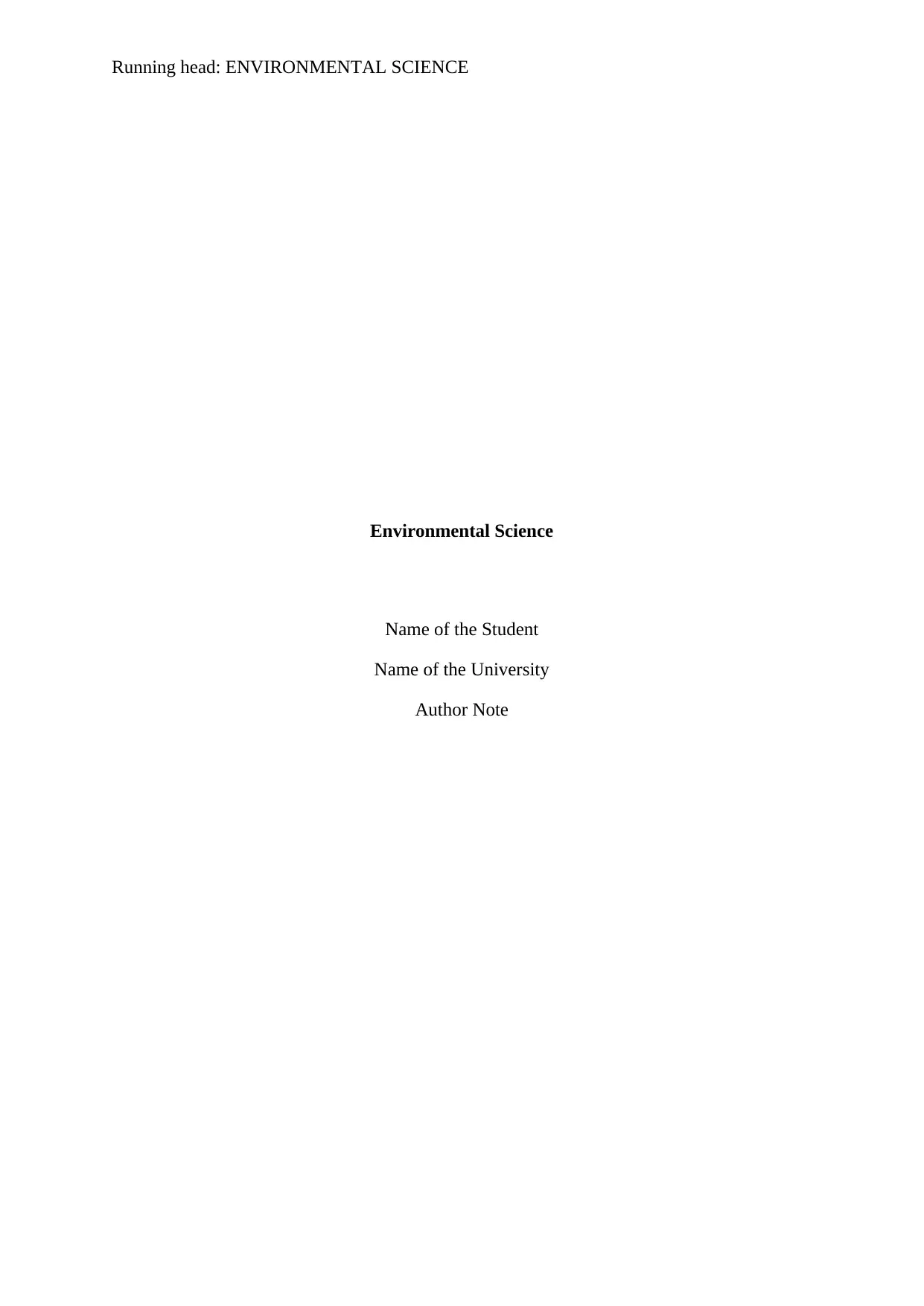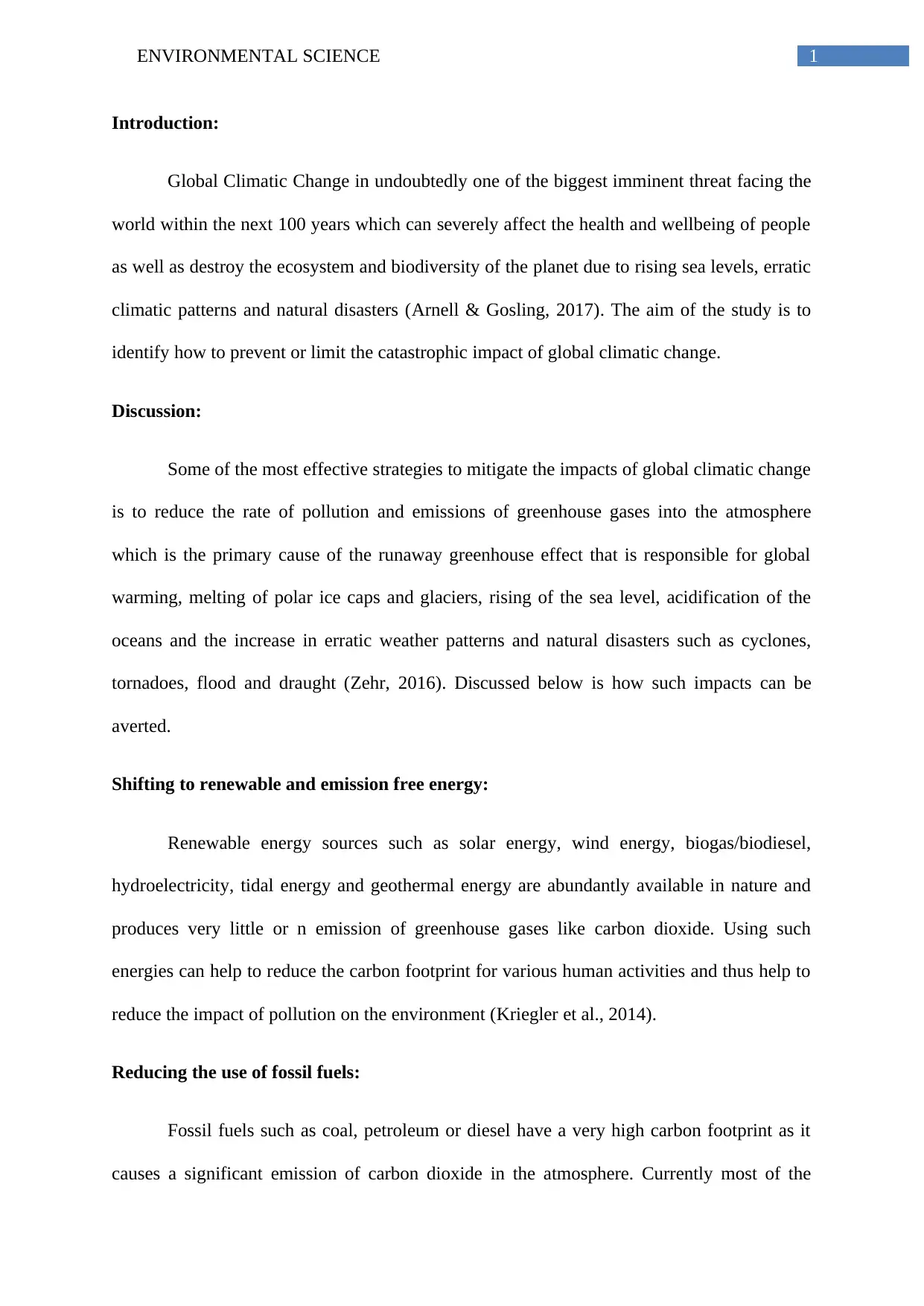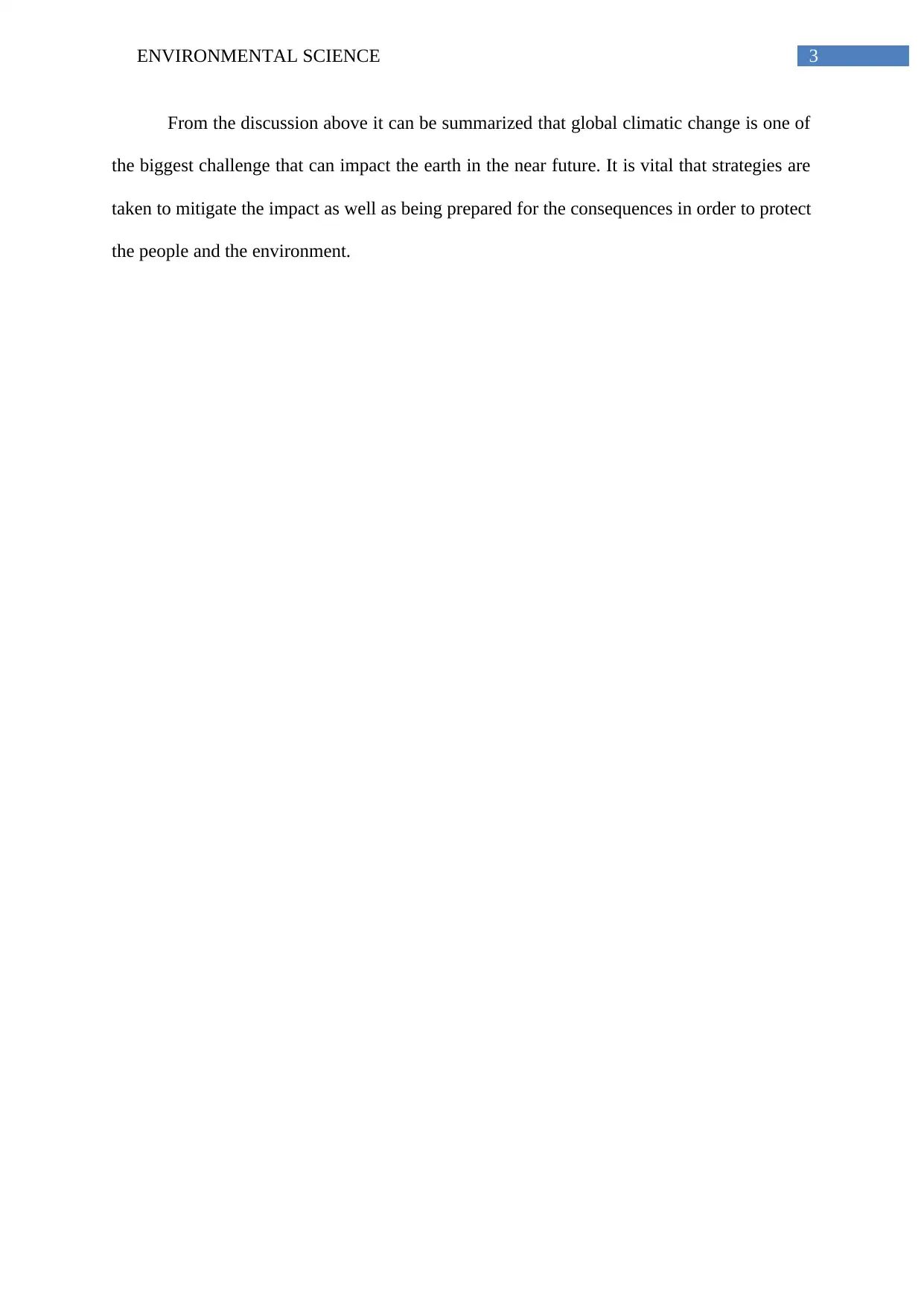Strategies for Combating Global Climatic Change: An Environmental View
VerifiedAdded on 2023/05/30
|6
|998
|251
Essay
AI Summary
This essay discusses the imminent threat of global climatic change and explores effective strategies to mitigate its catastrophic impacts. It emphasizes reducing pollution and greenhouse gas emissions through shifting to renewable energy sources, reducing the use of fossil fuels, preventing energy wastage, and implementing pollution taxes. Additionally, it addresses the need for preparedness for sea-level rise, including building embankments, improving drainage systems, and planning for resettlement. The essay concludes that proactive mitigation and preparedness are vital for protecting both people and the environment from the adverse effects of climatic change. Desklib provides access to similar essays and study tools for students.

Running head: ENVIRONMENTAL SCIENCE
Environmental Science
Name of the Student
Name of the University
Author Note
Environmental Science
Name of the Student
Name of the University
Author Note
Paraphrase This Document
Need a fresh take? Get an instant paraphrase of this document with our AI Paraphraser

1ENVIRONMENTAL SCIENCE
Introduction:
Global Climatic Change in undoubtedly one of the biggest imminent threat facing the
world within the next 100 years which can severely affect the health and wellbeing of people
as well as destroy the ecosystem and biodiversity of the planet due to rising sea levels, erratic
climatic patterns and natural disasters (Arnell & Gosling, 2017). The aim of the study is to
identify how to prevent or limit the catastrophic impact of global climatic change.
Discussion:
Some of the most effective strategies to mitigate the impacts of global climatic change
is to reduce the rate of pollution and emissions of greenhouse gases into the atmosphere
which is the primary cause of the runaway greenhouse effect that is responsible for global
warming, melting of polar ice caps and glaciers, rising of the sea level, acidification of the
oceans and the increase in erratic weather patterns and natural disasters such as cyclones,
tornadoes, flood and draught (Zehr, 2016). Discussed below is how such impacts can be
averted.
Shifting to renewable and emission free energy:
Renewable energy sources such as solar energy, wind energy, biogas/biodiesel,
hydroelectricity, tidal energy and geothermal energy are abundantly available in nature and
produces very little or n emission of greenhouse gases like carbon dioxide. Using such
energies can help to reduce the carbon footprint for various human activities and thus help to
reduce the impact of pollution on the environment (Kriegler et al., 2014).
Reducing the use of fossil fuels:
Fossil fuels such as coal, petroleum or diesel have a very high carbon footprint as it
causes a significant emission of carbon dioxide in the atmosphere. Currently most of the
Introduction:
Global Climatic Change in undoubtedly one of the biggest imminent threat facing the
world within the next 100 years which can severely affect the health and wellbeing of people
as well as destroy the ecosystem and biodiversity of the planet due to rising sea levels, erratic
climatic patterns and natural disasters (Arnell & Gosling, 2017). The aim of the study is to
identify how to prevent or limit the catastrophic impact of global climatic change.
Discussion:
Some of the most effective strategies to mitigate the impacts of global climatic change
is to reduce the rate of pollution and emissions of greenhouse gases into the atmosphere
which is the primary cause of the runaway greenhouse effect that is responsible for global
warming, melting of polar ice caps and glaciers, rising of the sea level, acidification of the
oceans and the increase in erratic weather patterns and natural disasters such as cyclones,
tornadoes, flood and draught (Zehr, 2016). Discussed below is how such impacts can be
averted.
Shifting to renewable and emission free energy:
Renewable energy sources such as solar energy, wind energy, biogas/biodiesel,
hydroelectricity, tidal energy and geothermal energy are abundantly available in nature and
produces very little or n emission of greenhouse gases like carbon dioxide. Using such
energies can help to reduce the carbon footprint for various human activities and thus help to
reduce the impact of pollution on the environment (Kriegler et al., 2014).
Reducing the use of fossil fuels:
Fossil fuels such as coal, petroleum or diesel have a very high carbon footprint as it
causes a significant emission of carbon dioxide in the atmosphere. Currently most of the

2ENVIRONMENTAL SCIENCE
industries still depend on these forms of energy which increases the risks of adverse
environmental impact. Shifting away from these energy sources can help to mitigate that risk
(Bauer et al., 2016).
Preventing wastage of energy:
By optimizing the usage of energy and preventing its wastage as well as using waste
as energy source is another strategy to reduce the carbon footprint and mitigate the impact on
the environment due to human activities. By reducing the wastage of energy, the availability
of the energy can be increased thereby helping to avert the adverse effect of climatic change
(Pan et al., 2015).
Implementing Pollution Taxes:
A good way to deter industries from the usage of high emission energy sources and
cause environmental pollution is to implement pollution taxes in which they would have to
pay a tax that according to the amount of pollution they produce (Klausbruckner et al., 2016).
Being ready for sea level rise:
With the current rate of emissions and changes to the global climate and the current
rate at which the polar ice caps and the glaciers are melting around the world, a rise in the sea
level is imminent in the next few decades. It is expected that low lying areas and coastlines
can be the worst affected due to a rise in sea level which can displace millions of people. This
can be averted by building embankments to prevent the sea water from entering and good
drainage systems to drain the storm waters to the ocean. Additionally, it can also be useful to
have preparations for resettlement of people in the high risk areas in an event of sea level rise
(Zehr, 2016).
Conclusion:
industries still depend on these forms of energy which increases the risks of adverse
environmental impact. Shifting away from these energy sources can help to mitigate that risk
(Bauer et al., 2016).
Preventing wastage of energy:
By optimizing the usage of energy and preventing its wastage as well as using waste
as energy source is another strategy to reduce the carbon footprint and mitigate the impact on
the environment due to human activities. By reducing the wastage of energy, the availability
of the energy can be increased thereby helping to avert the adverse effect of climatic change
(Pan et al., 2015).
Implementing Pollution Taxes:
A good way to deter industries from the usage of high emission energy sources and
cause environmental pollution is to implement pollution taxes in which they would have to
pay a tax that according to the amount of pollution they produce (Klausbruckner et al., 2016).
Being ready for sea level rise:
With the current rate of emissions and changes to the global climate and the current
rate at which the polar ice caps and the glaciers are melting around the world, a rise in the sea
level is imminent in the next few decades. It is expected that low lying areas and coastlines
can be the worst affected due to a rise in sea level which can displace millions of people. This
can be averted by building embankments to prevent the sea water from entering and good
drainage systems to drain the storm waters to the ocean. Additionally, it can also be useful to
have preparations for resettlement of people in the high risk areas in an event of sea level rise
(Zehr, 2016).
Conclusion:
⊘ This is a preview!⊘
Do you want full access?
Subscribe today to unlock all pages.

Trusted by 1+ million students worldwide

3ENVIRONMENTAL SCIENCE
From the discussion above it can be summarized that global climatic change is one of
the biggest challenge that can impact the earth in the near future. It is vital that strategies are
taken to mitigate the impact as well as being prepared for the consequences in order to protect
the people and the environment.
From the discussion above it can be summarized that global climatic change is one of
the biggest challenge that can impact the earth in the near future. It is vital that strategies are
taken to mitigate the impact as well as being prepared for the consequences in order to protect
the people and the environment.
Paraphrase This Document
Need a fresh take? Get an instant paraphrase of this document with our AI Paraphraser

4ENVIRONMENTAL SCIENCE
References:
Arnell, N. W., & Gosling, S. N. (2016). The impacts of climate change on river flood risk at
the global scale. Climatic Change, 134(3), 387-401.
Bauer, N., Mouratiadou, I., Luderer, G., Baumstark, L., Brecha, R. J., Edenhofer, O., &
Kriegler, E. (2016). Global fossil energy markets and climate change mitigation–an
analysis with REMIND. Climatic Change, 136(1), 69-82.
Klausbruckner, C., Annegarn, H., Henneman, L. R., & Rafaj, P. (2016). A policy review of
synergies and trade-offs in South African climate change mitigation and air pollution
control strategies. Environmental Science & Policy, 57, 70-78.
Kriegler, E., Weyant, J. P., Blanford, G. J., Krey, V., Clarke, L., Edmonds, J., ... & Rose, S.
K. (2014). The role of technology for achieving climate policy objectives: overview
of the EMF 27 study on global technology and climate policy strategies. Climatic
change, 123(3-4), 353-367.
Pan, S. Y., Du, M. A., Huang, I. T., Liu, I. H., Chang, E. E., & Chiang, P. C. (2015).
Strategies on implementation of waste-to-energy (WTE) supply chain for circular
economy system: a review. Journal of Cleaner Production, 108, 409-421.
Zehr, S. C. (2016). Public representations of scientific uncertainty about global climate
change. Public Understanding of Science.
References:
Arnell, N. W., & Gosling, S. N. (2016). The impacts of climate change on river flood risk at
the global scale. Climatic Change, 134(3), 387-401.
Bauer, N., Mouratiadou, I., Luderer, G., Baumstark, L., Brecha, R. J., Edenhofer, O., &
Kriegler, E. (2016). Global fossil energy markets and climate change mitigation–an
analysis with REMIND. Climatic Change, 136(1), 69-82.
Klausbruckner, C., Annegarn, H., Henneman, L. R., & Rafaj, P. (2016). A policy review of
synergies and trade-offs in South African climate change mitigation and air pollution
control strategies. Environmental Science & Policy, 57, 70-78.
Kriegler, E., Weyant, J. P., Blanford, G. J., Krey, V., Clarke, L., Edmonds, J., ... & Rose, S.
K. (2014). The role of technology for achieving climate policy objectives: overview
of the EMF 27 study on global technology and climate policy strategies. Climatic
change, 123(3-4), 353-367.
Pan, S. Y., Du, M. A., Huang, I. T., Liu, I. H., Chang, E. E., & Chiang, P. C. (2015).
Strategies on implementation of waste-to-energy (WTE) supply chain for circular
economy system: a review. Journal of Cleaner Production, 108, 409-421.
Zehr, S. C. (2016). Public representations of scientific uncertainty about global climate
change. Public Understanding of Science.

5ENVIRONMENTAL SCIENCE
⊘ This is a preview!⊘
Do you want full access?
Subscribe today to unlock all pages.

Trusted by 1+ million students worldwide
1 out of 6
Related Documents
Your All-in-One AI-Powered Toolkit for Academic Success.
+13062052269
info@desklib.com
Available 24*7 on WhatsApp / Email
![[object Object]](/_next/static/media/star-bottom.7253800d.svg)
Unlock your academic potential
Copyright © 2020–2025 A2Z Services. All Rights Reserved. Developed and managed by ZUCOL.





